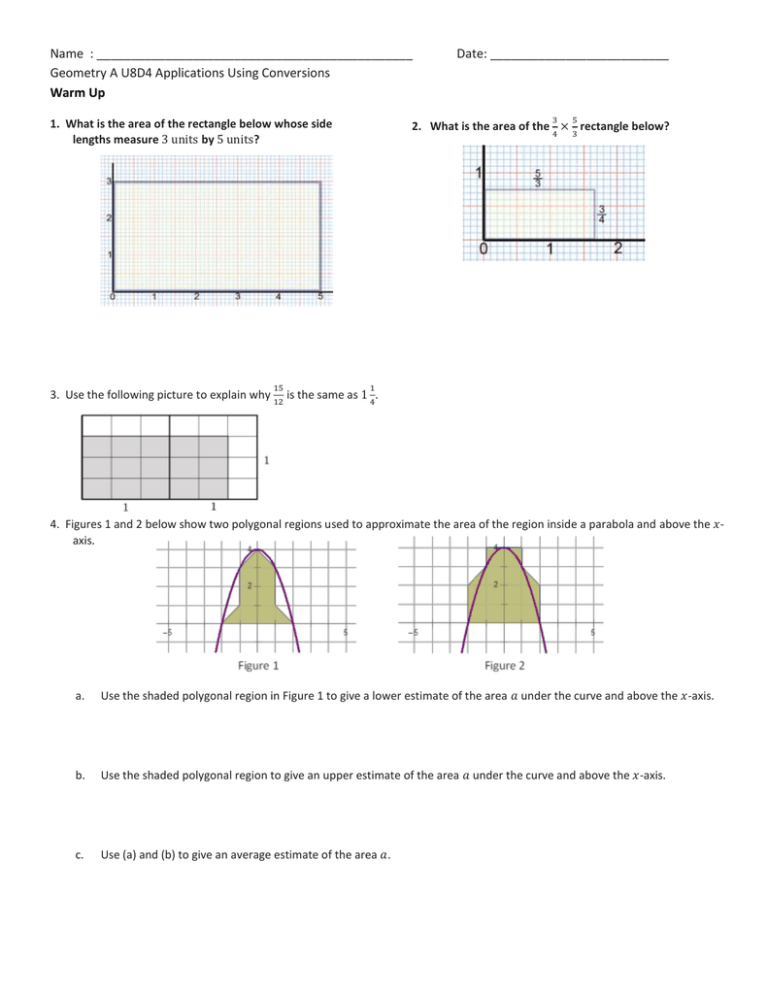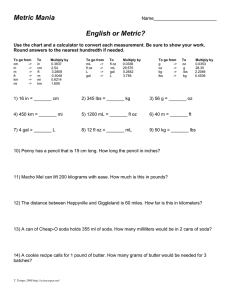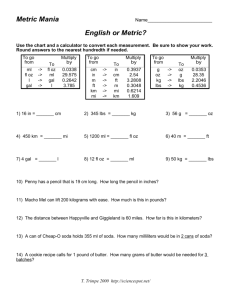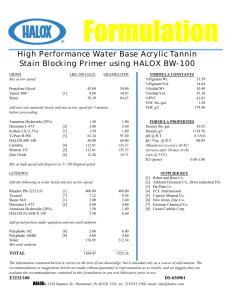U8D4 Conversions
advertisement

Name : ______________________________________________ Geometry A U8D4 Applications Using Conversions Warm Up 1. What is the area of the rectangle below whose side lengths measure 3 units by 5 units? 3. Use the following picture to explain why 15 12 Date: __________________________ 3 5 4 3 2. What is the area of the × rectangle below? 1 is the same as 1 . 4 4. Figures 1 and 2 below show two polygonal regions used to approximate the area of the region inside a parabola and above the 𝑥axis. a. Use the shaded polygonal region in Figure 1 to give a lower estimate of the area 𝑎 under the curve and above the 𝑥-axis. b. Use the shaded polygonal region to give an upper estimate of the area 𝑎 under the curve and above the 𝑥-axis. c. Use (a) and (b) to give an average estimate of the area 𝑎. 1. 2. A rectangle with dimensions 21.6 × 12 has a right triangle with a base 9.6 and a height of 7.2 cut out of the rectangle. a. Find the area of the shaded region. b. Explain how you determined the area of the shaded region. Two triangles △ 𝐴𝐵𝐶 and △ 𝐷𝐸𝐹 are shown below. The two triangles overlap forming △ 𝐷𝐺𝐶. a. The base of figure 𝐴𝐵𝐺𝐸𝐹 is comprised of segments of the following lengths: 𝐴𝐷 = 4, 𝐷𝐶 = 3, and 𝐶𝐹 = 2. Calculate the area of the figure 𝐴𝐵𝐺𝐸𝐹. b. Explain how you determined the area of the figure. In the following triangular pyramid, a plane passes through the pyramid so that it is parallel to the base and results in the crosssection △ 𝐴′𝐵′𝐶′. The altitude from 𝑉 is drawn; the intersection of the altitude with the base is 𝑋, and the intersection of the altitude with the cross-section is 𝑋′. If the distance from 𝑋 to 𝑉 is 18 mm, the distance from 𝑋′ to 𝑉 is 12 mm, and the area of △ 𝐴′𝐵′𝐶′ is 28 mm2 , what is the area of △ 𝐴𝐵𝐶? Name : ______________________________________________ Date: __________________________ Geometry A U8D4 Applications Using Conversions 1) Change 12 lbs. into ounces. 12 oz. 48 oz. 96 oz. 192 oz. 2) Change 8 lbs. into ounces. 9) Change 312 oz. into pounds and ounces. 17 lb. 18 lb. 5 oz. 19 lb. 8 oz. 20 lb. oz. 4 oz. 128 oz. 32 oz. 3) Change 15 lbs. 5 oz. into ounces 245 oz. 30 oz. 10 oz. 240 oz. 10) Change 4 4) Change lbs. into ounces. 76 oz. 72 oz. 66 oz. 60 oz. lb. into ounces. 16 oz. 12 oz. 9 oz. 8 oz. 11) Change oz. lbs. into ounces. 96 oz. 98 oz. 100 oz. 122 5) Change 2 qt. into ounces. 128 oz. 96 oz. 64 oz. 32 oz. 6) Change 52 oz. into pounds and ounces. 3 lb. 6 oz. 3 lb. 8 oz. 32 oz. 3 lb. 4 oz. 12) Change lbs. into ounces. 136 oz. 144 oz. 152 oz. 160 oz. 7) Change 220 oz. into pounds and ounces. 13 lbs. 12 oz. 12 lbs. 10 oz. 10 lbs. 12 oz. 16 lbs. 10 oz. 13) Convert 6 pts. to qt. 3 qts. 4 qts. 8) Change 70 oz. into pounds and ounces. 2 lbs. 6 oz. 3 lbs. 1 oz. 3 lbs. 3 oz. 4 lbs. 6 oz. qts. 6 qts. 14) Convert c. to oz. 6 oz. 4 oz. 3 oz. 2 oz. 15) Convert 4 qt. to pts16 pts. 8 pts. 4 pts. 2 pts. 1. oz. 1 lb. Water Dry milk solids Sugar, granulated Yeast, compressed Flour, bread Salt Shortening, vegetable 17) Convert c. to oz. 4 oz. 2 oz. 1 oz. 3 oz. 1 lbs. = 2c. 1 oz. = 1 lb. 1 oz. 1 lb. 1 oz. 1 lb. = = = = = c. 2c. 3T. 4c. 2T. 2c. Use the recipe for soft rolls below. Convert the weight of the 16 oz. of dry milk solids to an equivalent volume measure using the weight/volume information. Soft Rolls Weight/Volume Information 9 lbs. 16 oz. 1 lb. 8 oz. 14 lbs. oz. 1 lb. 3. qt. to c. 12 c. 8 c. 4 c. 3 c. Use the recipe for soft rolls below. Convert the weight of the 9 lbs. of water to an equivalent volume measure using the weight/volume information. Soft Rolls Weight/Volume Information 9 lbs. 16 oz. 1 lb. 8 oz. 14 lbs. 2. 16) Convert Water Dry milk solids Sugar, granulated Yeast, compressed Flour, bread Salt Shortening, vegetable 1 lbs. = 2c. 1 oz. = 1 lb. 1 oz. 1 lb. 1 oz. 1 lb. = = = = = c. 2c. 3T. 4c. 2T. 2c. Use the recipe for soft rolls. Convert the weight of the 1 lb. of granulated sugar to an equivalent volume measure using the weight/volume information. Soft Rolls Weight/Volume Information 9 lbs. 16 oz. 1 lb. 8 oz. 14 lbs. oz. 1 lb. Water Dry milk solids Sugar, granulated Yeast, compressed Flour, bread Salt Shortening, vegetable 1 lbs. = 2c. 1 oz. = 1 lb. 1 oz. 1 lb. 1 oz. 1 lb. = = = = = c. 2c. 3T. 4c. 2T. 2c. 4. Use the recipe for soft rolls. Convert the weight of the 14 lbs. of bread flour to an equivalent volume measure using the weight/volume information. Soft Rolls Weight/Volume Information 9 lbs. 16 oz. 1 lb. 8 oz. 14 lbs. oz. 1 lb. 5. 1 lb. 1 oz. = 1 lb. 1 oz. 1 lb. 1 oz. 1 lb. = = = = = c. 2c. 3T. 4c. 2T. 2c. Water Dry milk solids Sugar, granulated Yeast, compressed Flour, bread Salt Shortening, vegetable 1 lbs. = 2c. 1 oz. = 1 lb. 1 oz. 1 lb. 1 oz. 1 lb. = = = = = c. 2c. 3T. 4c. 2T. 2c. Use the recipe for polenta. Convert the volume of the 2 qts. of water to an equivalent weight measure using the weight/volume information. Polenta Weight/Volume Information 2 qts. 2 t. 4 c. Water Salt Cornmeal 2 lbs. = 1 qt. 1 oz. = 8t. 1 lb. = 4c. Use the recipe for polenta. Convert the volume of the 2 t. of salt to an equivalent weight measure using the weight/volume information. Polenta Weight/Volume Information 2 qts. 2 t. 4 c. 8. 1 lbs. = 2c. Use the recipe for soft rolls. Convert the weight of the 4½ oz. of salt to an equivalent volume measure using the weight/volume information. Soft Rolls Weight/Volume Information oz. 7. Salt Shortening, vegetable 9 lbs. 16 oz. 1 lb. 8 oz. 14 lbs. 6. Water Dry milk solids Sugar, granulated Yeast, compressed Flour, bread Water Salt Cornmeal 2 lbs. = 1 qt. 1 oz. = 8t. 1 lb. = 4c. Use the recipe for basic pie dough. Convert the volume of the 3 c. of pastry flour to an equivalent weight measure using the weight/volume information. Basic Pie Dough Weight/Volume Information 3 c. 1 c. 2 t. 1 c. c. Flour, pastry Shortening, vegetable Salt Water, ice-cold 16 oz. 16 oz. 1 oz. 8 oz. = = = = Dry mild solids 1 oz. = 4 c. 2 c. 8 t. 2 c. c. 9. Use the recipe for basic pie dough. Convert the volume of the 1 c. of vegetable shortening to an equivalent weight measure using the weight/volume information. Basic Pie Dough Weight/Volume Information 3 c. 1 c. 2 t. 1 c. c. 10. 16 oz. 16 oz. 1 oz. 8 oz. = = = = Dry mild solids 1 oz. = 4 c. 2 c. 8 t. 2 c. c. Use the recipe for basic pie dough. Convert the volume of the 2 t. of salt to an equivalent weight measure using the weight/volume information. Basic Pie Dough Weight/Volume Information 3 c. 1 c. 2 t. 1 c. c. 11. Flour, pastry Shortening, vegetable Salt Water, ice-cold Flour, pastry Shortening, vegetable Salt Water, ice-cold 16 oz. 16 oz. 1 oz. 8 oz. = = = = Dry mild solids 1 oz. = 4 c. 2 c. 8 t. 2 c. c. Use the recipe for basic pie dough. Convert the volume of the 1 c. ice-cold water to an equivalent weight measure using the weight/volume information. Basic Pie Dough Weight/Volume Information 3 c. 1 c. 2 t. 1 c. c. Flour, pastry Shortening, vegetable Salt Water, ice-cold 16 oz. 16 oz. 1 oz. 8 oz. = = = = Dry mild solids 1 oz. = 4 c. 2 c. 8 t. 2 c. c. http://glencoe.mheducation.com/sites/0078690706/student_view0/math_quizzes2/math_quiz_3__pounds_and_ounces.html 12. Find the areas of the three triangles in the diagram below. Density Calculations UNITS OF DENSITY solids (g/cm3) 1. Find the unknown quantity: a) d = 3 g/mL V = 100 mL M=? 𝑑𝑒𝑛𝑠𝑖𝑡𝑦 = 𝑚𝑎𝑠𝑠 𝑣𝑜𝑙𝑢𝑚𝑒 liquids (g/mL) b) d = ? V = 950 mL M = 95 g c) d = 0.5 g/cm3 V=? M = 20 g 2. Find the unknown quantity (CONVERT FIRST to g or mL) a) d = 24 g/mL V = 1.2 L = _____ mL M=? b) d = ? V = 100 mL M = 1.5 kg = ______ g c) d = V = 0.52 L = ______ mL M = 500 mg = ______ g WORD PROBLEMS 1. A block of aluminum occupies a volume of 15.0 mL and weighs 40.5 g. What is its density? 2. Mercury metal is poured into a graduated cylinder that holds exactly 22.5 mL. The mercury used to fill the cylinder weighs 306.0 g. From this information, calculate the density of mercury. 3. What is the weight of the ethanol that exactly fills a 200.0 mL container? The density of ethanol is 0.789 g/mL. 4. A rectangular block of copper metal weighs 1896 g. The dimensions of the block are 8.4 cm by 5.5 cm by 4.6 cm. From this data, what is the density of copper? (hint: find the volume of a block first) 5. What volume of silver metal will weigh exactly 2500.0 g. The density of silver is 10.5 g/cm3. 6. Find the mass of 250.0 mL of benzene. The density of benzene is 0.8765 g/mL. 7. A block of lead has dimensions of 4.50 cm by 5.20 cm by 6.00 cm. The block weighs 1587 g. From this information, calculate the density of lead. 8. 28.5 g of iron shot is added to a graduated cylinder containing 45.50 mL of water. The water level rises to the 49.10 mL mark, From this information, calculate the density of iron. Name : ______________________________________________ Date: __________________________ Geometry A U8D4 Applications Using Conversions HOMEWORK 1. This is an extension of Problem 4 in the warm up. Using the diagram, draw grid lines to represent each 1 2 unit. d. How many squares do the new grid lines divide each unit square into? e. Use the squares described in part (a) to determine a lower estimate of area 𝑎 in the diagram. Find the area. f. Use the squares described in part (a) to determine an upper estimate of area 𝑎 in the diagram. Find the area. g. Calculate an average estimate of the area under the curve and above the 𝑥-axis based on your upper and lower estimates in parts (b) and (c). h. Do you think your average estimate is more precise here than it was in the warm up? Explain. 2. Two right prisms have similar bases. The first prism has height 5 and volume 100. A side on the base of the first prism has length 2, and the corresponding side on the base of the second prism has length 3. If the height of the second prism is 6, what is its volume? 3. a. Calculate the area of the shaded figure below. b. Explain how you determined the area of the figure. 4. In the following triangular pyramid, a plane passes through the pyramid so that it is parallel to the base and results in the crosssection △ 𝐴′𝐵′𝐶′. If the area of △ 𝐴𝐵𝐶 is 25 mm2 , what is the area of △ 𝐴′𝐵′𝐶′? 5) Change 48 oz. into pounds. 1 lb. 2 lbs. 3 lbs. 4 lbs. 6) Change 20 oz. into pounds and ounces. 2 lbs. 1 lb. 4 oz. 1 lb. 6 oz 1 lb. 8 oz Convert 3 gal. to c. 24 c. 48 c. 60 c. 96 c Convert 16 c. to gal. Convert 2 c. to pt. gal. pt. gal. 1 gal. pt. 1 pt. Convert 8 qts. to gal. 1 gal. 2 gal gal. pt. gal. 3 gal.




